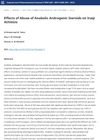Indirect Clinical Markers for the Detection of Anabolic Steroid Abuse Beyond Conventional Doping Control in Athletes
March 2019
in “
European Journal of Sport Science
”
anabolic androgenic steroids AAS high-density lipoprotein cholesterol HDL-C hematocrit serum gamma-glutamyl transpeptidase luteinizing hormone follicle-stimulating hormone hypertension acne testicular atrophy gynecomastia QT interval electrocardiogram liver enzymes hepatotoxicity dermatologic changes stretch marks voice deepening hirsutism androgenic alopecia steroids cholesterol blood thickness GGT LH FSH high blood pressure pimples shrunken testicles male breast enlargement heart rhythm ECG liver damage skin changes striae deep voice excessive hair growth male pattern baldness

TLDR New signs like changes in blood markers, physical symptoms, and behavioral shifts may help detect hidden steroid use in athletes.
The document from March 18, 2019, examines indirect clinical markers that can help detect anabolic androgenic steroid (AAS) abuse in athletes when conventional doping tests are negative. It identifies several laboratory markers and physical signs that may indicate AAS abuse, such as significant reductions in high-density lipoprotein cholesterol (HDL-C), increased hematocrit, elevated serum gamma-glutamyl transpeptidase levels, and in males, reduced serum levels of luteinizing hormone and follicle-stimulating hormone. Other signs include hypertension, behavioral changes, sudden onset of acne in adults, testicular atrophy, and gynecomastia in male athletes. The document also notes that chronic AAS abuse can decrease the QT interval on an electrocardiogram, increase liver enzymes indicating hepatotoxicity, and cause dermatologic changes like acne and stretch marks. In females, voice deepening, hirsutism, and androgenic alopecia may suggest AAS abuse, while in males, testicular atrophy and gynecomastia are indicators. The document concludes that these markers should be considered alongside other clinical markers for doping control and that further studies are needed to validate their use as complementary tools.






